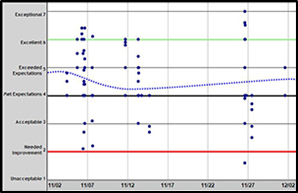Is Your Project Evaluation Plan Measuring all the Metrics You Need?
 Adding client feedback results to your project evaluation plan provides an incredible return on investment. Conversely, by failing to identify key satisfaction metrics, your projects are less efficient, and you have less insight in to the mindset of your clients. Ask yourself, in the modern competitive business environment, can your firm afford to overlook anything -- let alone the satisfaction of your clients?
Adding client feedback results to your project evaluation plan provides an incredible return on investment. Conversely, by failing to identify key satisfaction metrics, your projects are less efficient, and you have less insight in to the mindset of your clients. Ask yourself, in the modern competitive business environment, can your firm afford to overlook anything -- let alone the satisfaction of your clients?
Our easy to use client satisfaction solution, The Client Feedback Tool, allows clients to quickly and easily provide insightful data that will ensure that projects stay on course, and meet or exceed expectations. Utilizing our tool, asking your clients how your processes work takes them only two minutes to complete - but the information provided gives both parties valuable data to assure effective, successful projects.
Based on our research, including 100K pieces of data from our clients, we've listed 4 ways that feedback will add to your bottom line.
- Identify your top 10% most loyal clients. Do you have a way to identify which clients value you most? Using the information provided using the Client Feedback Tool, our clients have identified their top 10% most loyal clients and converted this knowledge into increased billings, increasing fees by 3% to their top-rating clients. For a $10 million firm, this translates into roughly $30k in additional profit each year.
- Retain one client on the "bubble." One-third of our subscribers came to us after losing a major client. In every case, these firms were surprised by the defection and realized they were blind to a pattern of problems the client never brought to light. Frequent feedback greatly reduces the chances of this happening.
According to PSMJ Resources:
- AEC firms spend four times more money replacing a client than the costs of retaining one.
- Even if you replace the lost revenue of a departed client, the added cost of winning a new client typically exceeds $22k.
- Increase marketing efficiency by 3%. The average AEC firm spends 11% of their revenue marketing, while seeing only 25% of pursued work turns into billable work. Adding client feedback informs you of your market successes and identifies where your firm’s strengths are. By marketing your strengths to your best market sectors, you’ll not only target the markets that are most satisfying (and profitable), you will also reduce wasted effort pursuing work that doesn't match your firm's core services. Even a 3% increase in efficiency will save a $10 million firm over $33k a year.
- Reduce key staff departure by 5%. PSMJ Resources again reports that replacing your best staff costs in excess of $100k per departure. Most key staff don’t leave for better salary. They leave because they feel unappreciated, unvalued, and because they feel their growth is not supported. Quantitative feedback gives you the tools and information to recognize performance. In fact, your clients will be directly recognizing your staff’s efforts as they provide feedback. Research based on nearly 10 years of helping our clients collect feedback indicates that their clients rate staff performance as "Exceptional" 22% of the time. This satisfying work environment will help retain (and identify) your best people, saving an average of $67k each year.
It’s simple, regardless of firm size, incorporating feedback in to your project evaluation plan can increase profits 13% or more just by applying these tools and strategies.
Garnering the client feedback metrics needed for your project evaluation plan is easy with a simple and powerful system like The Client Feedback Tool.




 As a project manager you have more to do in any given day than you can possibly get done. Sound about right? And, as if you don’t have enough to do, you sit through team meetings, office meetings, and visits from the top leadership where they remind you how important it is to ensure your clients are your top priority while also achieving strong profits. Okay. Now for the big question – how do you balance both priorities?
As a project manager you have more to do in any given day than you can possibly get done. Sound about right? And, as if you don’t have enough to do, you sit through team meetings, office meetings, and visits from the top leadership where they remind you how important it is to ensure your clients are your top priority while also achieving strong profits. Okay. Now for the big question – how do you balance both priorities? Every time one of our clients sends a survey, their clients’ responses are logged onto a scatter plot like the one in this figure. One of several reporting options, the scatter plot analyzes how well client expectations are being met. It takes less than a minute to run and you can schedule it as a weekly or monthly recurring report. Our clients see a snapshot of what their clients are saying. Are you starting to see how this will give you the information you need?
Every time one of our clients sends a survey, their clients’ responses are logged onto a scatter plot like the one in this figure. One of several reporting options, the scatter plot analyzes how well client expectations are being met. It takes less than a minute to run and you can schedule it as a weekly or monthly recurring report. Our clients see a snapshot of what their clients are saying. Are you starting to see how this will give you the information you need?
 If you ask friends or colleagues how they feel about conflict, you will likely know their answer even before they speak. Their body language will tell you immediately. That is because most people view conflict as having to do with arguments, agitation, and to an extreme extent, hostility. But what if we reframe the way we look at conflict? Is there a way to see conflict as an opportunity if we accept the fact that conflict is essentially about the gaps in expectations that happen when individuals interact?
If you ask friends or colleagues how they feel about conflict, you will likely know their answer even before they speak. Their body language will tell you immediately. That is because most people view conflict as having to do with arguments, agitation, and to an extreme extent, hostility. But what if we reframe the way we look at conflict? Is there a way to see conflict as an opportunity if we accept the fact that conflict is essentially about the gaps in expectations that happen when individuals interact? Achieving consistent project profitability while maintaining strong client relationships is at the top of most firms’ goals and objectives. And, while there are certainly a number of variables that must be integrated to make this happen, asking your clients for feedback during the project plays a valuable role. I’ve identified two scenarios that are common in the A/E industry. Incorporating feedback into your project management process has been demonstrated to have a positive impact on both.
Achieving consistent project profitability while maintaining strong client relationships is at the top of most firms’ goals and objectives. And, while there are certainly a number of variables that must be integrated to make this happen, asking your clients for feedback during the project plays a valuable role. I’ve identified two scenarios that are common in the A/E industry. Incorporating feedback into your project management process has been demonstrated to have a positive impact on both.
 Your firm is committed to using client evaluation surveys to ensure project success. So what do you do when your client gives you all high marks and you just know it isn’t true?
Your firm is committed to using client evaluation surveys to ensure project success. So what do you do when your client gives you all high marks and you just know it isn’t true?
 Each of your clients, like you, are individuals that have a unique definition for what a positive client service experience means to them. We can no longer treat everyone the same way – it just doesn’t work! Sending client surveys gives your firm the opportunity to ask clients what that terrific experience looks like to them – each of them. It also gives you the chance to show that your firm is serious about their satisfaction and to build stronger relationships. As a result of the thousands of survey results and comments we’ve seen, we wanted to share with you the top 3 reasons clients want you to send them a client survey.
Each of your clients, like you, are individuals that have a unique definition for what a positive client service experience means to them. We can no longer treat everyone the same way – it just doesn’t work! Sending client surveys gives your firm the opportunity to ask clients what that terrific experience looks like to them – each of them. It also gives you the chance to show that your firm is serious about their satisfaction and to build stronger relationships. As a result of the thousands of survey results and comments we’ve seen, we wanted to share with you the top 3 reasons clients want you to send them a client survey. But it’s not just the act of measuring – it’s measuring the RIGHT things and then utilizing what was learned from the results. When trying to improve the performance and evaluation of your team or team members, what should be measured (and how) become critical questions.
But it’s not just the act of measuring – it’s measuring the RIGHT things and then utilizing what was learned from the results. When trying to improve the performance and evaluation of your team or team members, what should be measured (and how) become critical questions. 1.jpg?width=268&height=297&name=project_success_(ryan_suydam)1.jpg)
 1. Make it Comfortable.
1. Make it Comfortable.